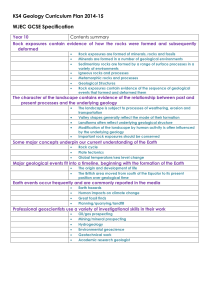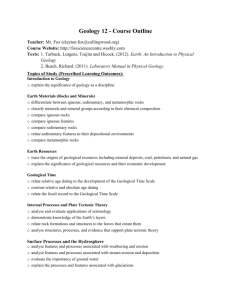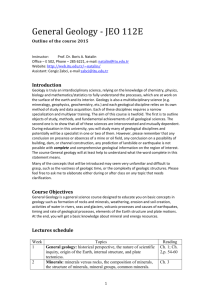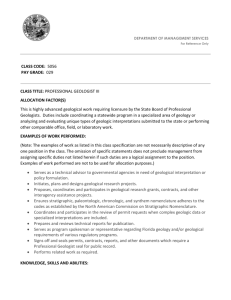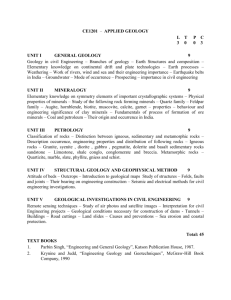General Geology-2081_course
advertisement
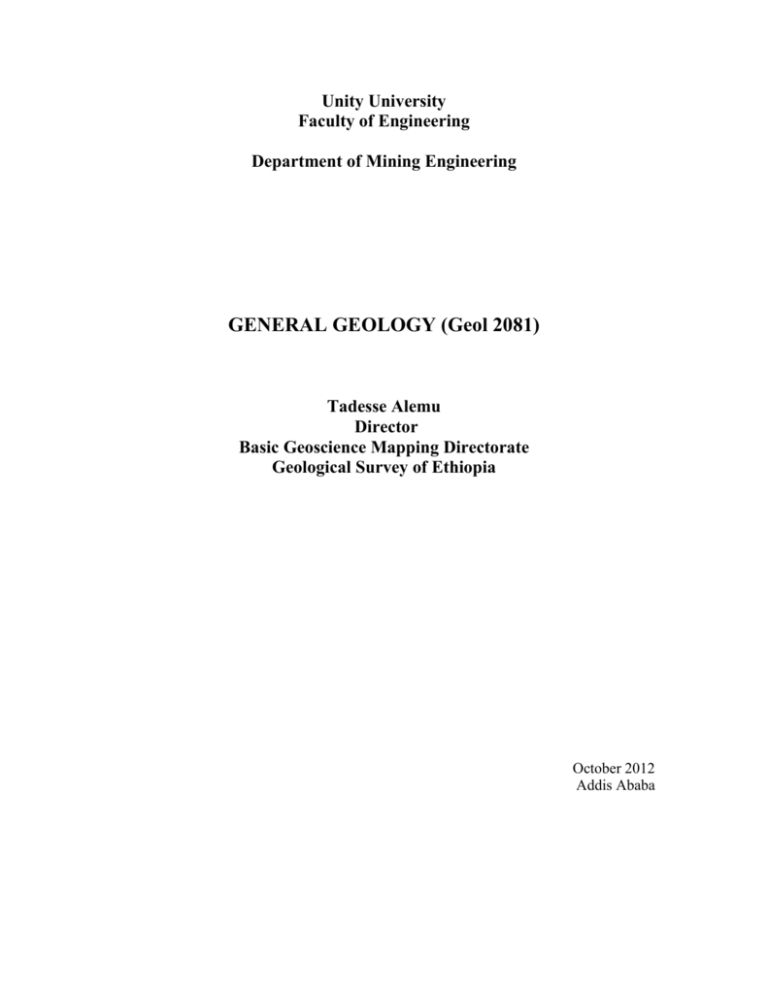
Unity University Faculty of Engineering Department of Mining Engineering GENERAL GEOLOGY (Geol 2081) Tadesse Alemu Director Basic Geoscience Mapping Directorate Geological Survey of Ethiopia October 2012 Addis Ababa GENERAL GEOLOGY (GEOL 2081) 1. Course Description: This course is broad reviews on the subjects of general geology for students with aim to acquire knowledge on the rock associations, origin, tectonic settings and conditions of formation of rocks. The course begins with making the students familiar with, composition, structure and materials of the solid earth, rock deformation and tectonics, evolution of the earth through geologic time and end with brief review of the Geology of Ethiopia. 2. Learning Outcome / Objectives At the end of the module the learner must be able to: Discuss the basic internal structure of the Earth and the unique properties of each layer. Explain plate tectonic features and processes. Identify, classify, and describe minerals and rocks based on physical properties and textures. Interpret geologic environments based on rock type. Formulate interpretations of various geologic features based on the application of fundamental geologic concepts. Recognize and evaluate geological structures Relate geologic concepts (e.g. stratigraphic principles, relative dating relationships) Discuss geologic time, basic stratigraphic principles, and explain clearly the major geological time divisions that have been important in the formation of the earth Explain the geological evolution of Ethiopia 3. Course Contents 1. Introduction 1.1. Scope in Mining Engineering 1.2. Branches of Geology 1.3. The Planet Earth 2. Composition and Structure of the solid earth 2.1. The Interior Earth 2.2. The Mantle 2.3. The Earth’s Crust 3. Minerals and Rocks 3.1. Introduction to rock-forming minerals 3.2. Igneous Rocks 3.2.1. Origin of Igneous rocks 3.2.2. Mode of occurrence of igneous bodies 3.2.3. Texture of Igneous rocks 3.2.4. Classification of Igneous rocks 3.3. Sedimentary Rocks 3.3.1. Nature and Origin of Sedimentary rocks 3.3.2. Texture and Structure of Sedimentary rocks 3.3.3. Depositional Environments of Sedimentary rocks 3.4. Metamorphic Rocks 3.4.1. Definitions of Metamorphism 3.4.2. Types of Metamorphism 3.4.3. Grade of Metamorphism 3.4.4. Classification of Metamorphic rocks 3.4.5. Structure of Metamorphic rocks 4 Structural Geology and Tectonics 4.1. Introduction to Deformation and Strain 4.2. Primary Structures 4.3. Folds 4.3.1. Description of folds 4.3.2. Orientation of folds 4.3.3. Classification of folds 4.4. Foliations 4.5. Lineations 4.6. Joints 4.6.1. Terminology of Joints 4.6.2. Genetic classification of Joints 4.6.3. Relation of joints to other structures 4.7. Faults 4.7.1. Fault terminology 4.7.2. Nature of movement along faults 4.7.3. Thrust Fault 4.7.4. Normal Faults 4.7.5. Strike-slip Faults 4.7.6. Shear zones 4.8. Introduction to Plate Tectonics 5 Physical Geology and Geomorphology 5.1. Fundamental concepts 5.2. Weathering 5.3. Geomorphologic processes 5.4. Hydrogeology 5.5. Geological mapping 6 Evolution of the Earth 3.4. Introduction 3.5.The Precambrian Earth 3.6.The Paleozoic Earth 3.7.The Mesozoic Earth 3.8.The Cenozoic Earth 7 Mineral Resources 8 Geology of Ethiopia 3.4.Introduction 3.5.Precambrian Rocks 3.6.Paleo-Mesozoic Sedimentary Rocks 3.7.Cenozoic Volcanics and associated Sedimentary Rocks Learning Methods Discussion and/presentation Lecture Demonstration Project Practical exercise Basic Geological Mapping 3.3 Course Description: The course is designed to introduce and acquired the trainees with basic geological mapping techniques which are pertinent in groundwater investigations. In all cases emphasis is given to: - (i) Interpretation of Topographic maps, Aerial photographs and Landsat images, (ii) Field description and mapping of lithology and structures, (iii) Methods of recording field observations on base map, and (iv) Interpretation and compilation of field observations 3.4 Learning Outcome / Objectives At the end of the module the learner must be able to: Use a topographic map to determine location, elevation, gradient, and distance. Interpret and identify various geologic landforms (e.g., desert, glacial, fluvial, and volcanic features) on aerial photographs, landsat and topographic maps, and interpret their origin and evolution. Identify and explain geologic features in a field environment. Make systematic observations, descriptions and recording of field observations Apply appropriate lithological names. Establish litho-stratigraphic sequences, and the relationships between lithology and structure. Perform detail lithological and structural mapping in the groundwater exploration. Produce an accurate and valid geological map. 3.5 Module Contents 1 Introduction 1.1. Value of geological mapping 1.2. Type of geological maps 2. Office Techniques in geological mapping 2.1. Topographic maps – basic map reading skills 2.2. Aerial photo and Image Interpretation 2.2.1. The recognition of rock types 2.2.2. Stratigraphic relationships 2.2.3. Structural relationships 2.3. Interpretation of Geological maps and cross-sections 3. Field geological mapping 3.1. Field equipments and Materials 3.2. Philosophy and organizing field work. o Geological and Topo maps o Selecting a field study o Reconnaissance survey o Preparation for field work o Field traverse line & order of information record o Outcrop analysis and record o Compilation of field data 4. Identification and naming of lithostratigraphic units 4.1. Logging of stratigraphic sections 4.2. Presentation of stratigraphic sections 4.3. Procedures for establishing lithostratigraphic unit 4.4. Correlation techniques on different basis 4.5. Geological mapping in Volcanic terrain 4.6. Geological mapping in Sedimentary terrain 4.7. Geological mapping in Metamorphic terrain 5. Mapping geologic structures 5.1. Recognition of folds 5.2. Description of folds 5.3. Field criteria for recognition of faults 5.4. Recognition of unconformities Learning Methods Discussion and/presentation Lecture Demonstration Project Practical exercise


